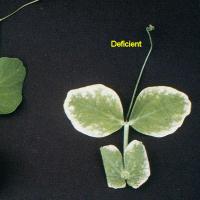Diagnosing zinc deficiency in field peas
Field peas are susceptible to zinc deficiency, but is rarely seen in WA.
What to look for
- Plants with white necrotic older leaves and considerable variation in severity of symptoms between plants.
- Deficiency will vary with soil type, being worst on highly alkaline soils.
- Deficiency may be worse in cold wet weather.
Paddock
- Older leaves of young plants may initially wilt.
- Cream-coloured necrosis on older leaf margins moves to the midrib, leaving a small green residual at the leaf base. The whole leaf turns white and dies.
- Tendrils go limp, curl and finally die.
- Later, new leaves are small, pale and cupped.
- Red-brown lesions develop on new leaf and upper main stems.
Plant
What else could it be
| Condition | Similarities | Differences |
|---|---|---|
| Diagnosing potassium deficiency in field peas | Older leaf pale necrosis. | Pinkish pale necrotic spots |
| Diagnosing boron toxicity in field peas | Pale marginally necrotic old leaves | Symptoms appear in late rather than early growth stage |
| Diagnosing group C herbicide damage in field peas | Older leaf pale necrosis. | Plants are very stunted, may die, and are more uniformly affected. |
| Diagnosing soil acidity in field peas | Older leaf pale necrosis. | Necrotic leaf patches rather than margins, stunted roots, mainly lighter textured soils |
Where does it occur?

Soil type

Temperature

Dry conditions
- Most sandy surfaced soils required copper and zinc when initially cleared for agriculture.
- Zinc deficiency is also common on highly alkaline soils, and may be induced by cold wet weather.
- Zinc is relatively immobile in soil and becomes unavailable to crops in dry soil.
- Where soil levels are marginal, zinc deficiency may be induced by applications of lime to acidic soils.
Management strategies

Spraying foliar
- Foliar spray (effective only in current season) or soil fertiliser drilled with the following crop.
- Zinc foliar sprays need to be applied as soon as deficiency is detected to avoid irreversible damage.
- As zinc is immobile in the soil, topdressing is ineffective, as it would only be available to the plant when the topsoil is wet.
- Zinc drilled deep increases the chances of roots being able to obtain enough in dry seasons.
- Zinc has a 15 to 20 year residual life in soil.
- Zinc present in compound fertilisers often meets the current requirements of the crop.
How can it be monitored?

Soil test
- As zinc is immobile in the plant, young shoot or young leaf sampling is most accurate, but Australian laboratory standards have not been established for field peas. A guide from literature is 20mg/kg. Sample paired good and poor plants at the same growth stage.
- A DTPA zinc soil test provides at best a rough guide to soil zinc status. The critical concentration for cereals varies with soil type. For example acid sands about 0.2 mg/kg while alkaline clay require about 0.45 mg Zn kg soil.
See also
Further information
Where to go for expert help
Page last updated: Wednesday, 13 May 2015 - 1:10pm





